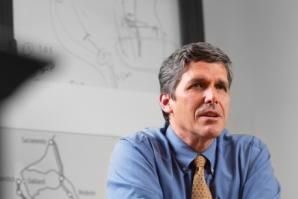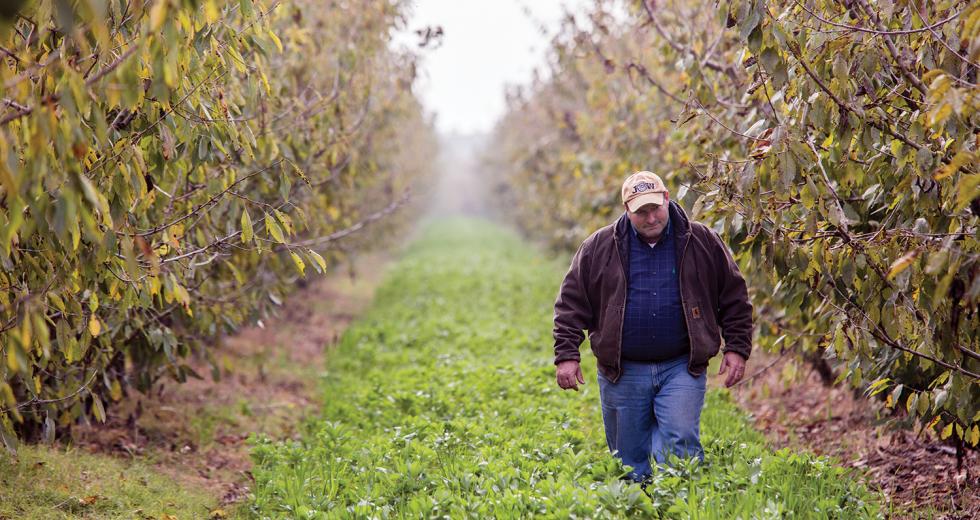City dwellers driving past the expansive cotton fields and scattered farmhouses along Highway 43 to Corcoran might get the feeling they’ve left California. A haze of dust, bugs and little particles of cow dung blanket the road between Fresno and Bakersfield. Even on a nice day, wiping debris from a car windshield begins to feel futile.
The idea of an electric-powered train streaking past the town and pastures every eight minutes seems otherworldly, like a blue-and-yellow spaceship barreling in from the future. But California’s 220 mph high-speed rail would do just that, if the project were ever completed.
This year, the California High Speed Rail Authority received approximately $3 billion in state bonds and another $3 billion in federal stimulus to begin building the first stretches of track from Merced to Fresno and then on to Bakersfield. But citizens from small farming communities across the San Joaquin Valley have responded with environmental lawsuits. Many farmers originally supported the train proposal on the 2008 statewide ballot, but they assumed the tracks would run along Highway 99 or Interstate 5, not through their homes, dairies, trailer parks and farmland.
Since most of the federal dollars must be spent by 2017, a dragged-out court battle threatens to shut down the entire undertaking.
“I’m fighting for the citizens of Corcoran,” says Charlene Hook, who claims that one of three proposed train routes would go directly through her home and the homes of her two sisters. A quarter of Corcoran’s 25,000 residents live below the poverty line, and only about 4 percent have a bachelor’s degree or higher. The town is 62 percent Latino.
“(The authority) thought we were hillbillies that wouldn’t say anything,” Hook says. “Now they’re getting a rude awakening, like yes, we do fight.”
If high-speed rail is defeated, the rural protestors will owe some success to a heated argument that occurred May 5, 2011. Curt Pringle, former chairman to the California High Speed Rail Authority, conducted a hearing in Sacramento that day and traded sharp words with a Kings County farming representative. A video of the exchange appeared on YouTube and spread across small communities outside Fresno. Farmers began holding public meetings and organizing a resistance.
Opponents charge rail officials with refusing to modify route proposals following their concerns and suggestions. Other residents contend they have been denied due process rights. The authority stresses that significant efforts are being made to meet with locals to identify and mitigate potential damage. But fighting off railroad interests is part of Central Valley lore, and some rail opponents claim to feel empowered by a sense of legacy. Others simply believe litigation is necessary to protect their homes.
On the outskirts of Chowchilla in Madera County, Nellie and Domingos Ribeiro claim that one proposed train route would run through a manure treatment lagoon on their dairy farm. The family fears a forced relocation of the lagoon could ignite a chain reaction resulting in the closure of their property, which they purchased in 1990. “We don’t think (the authority) understands the impact, what the costs are that go into farming. They seem to minimize it,” Nellie Ribeiro says.
Frank Oliveira, a Hanford farmer, says another proposed train alignment cuts through five of his parcels, and the authority has provided only vague information about how he will access his land. “We are spending all this money just to protect ourselves from being abused by the state,” Oliveira says of the lawsuit. “But we will accomplish that.”
In July 2011, Oliveira helped establish Citizens for High Speed Rail Accountability. The group is one of several grassroots organizations across the state formed to educate citizens about the authority and, in some cases, organize a multi-pronged prosecution against it. Sacramento is home to the California Rail Foundation, another citizen group operates out of Alhambra and at least three others are based along the San Francisco peninsula.
Together, these organizations make up an alliance of rural residents whose land or properties might be displaced by the tracks, high-speed rail supporters who disagree with the authority’s actions and Tea Partiers who fundamentally object to a government-financed train.
“I think this is a catalyst for community building,” says Oliveira, 54, who says this is his first experience in activism. “It has rallied our community around a common threat, and we do know each other better.”
“(The authority) thought we were hillbillies that wouldn’t say anything. Now they’re getting a rude awakening, like yes, we do fight.”
Charlene Hook, Corcoran resident and high-speed rail opponent
Madera residents have filed lawsuits contending that rail officials conducted inadequate environmental surveys when drawing track alignments from Madera to Fresno. The suits are headed for a Sacramento court this spring. Additional litigation is expected from property owners in Kings and Kern counties as the authority moves its planning south.
When Californians approved public financing for high-speed rail
in 2008, gasoline prices had surged to record highs that summer
before sharply declining in time for the November election. The
rail was presented to voters as a way to reduce the state’s
dependence on foreign oil while adding jobs and reducing air
pollution and urban sprawl. With California’s population
predicted to reach 50 million by 2030, those concerns have not
faded.
The measure directed $9 billion in state bonds for the construction of an electric-powered train that would dart passengers from San Francisco to Los Angeles in about two and a half hours for roughly $50 a ticket. The authority has received enough public money to build the first 130-mile stretch across the greater Fresno area, but funding is not yet available to electrify the tracks, purchase the trains or build the stations. Rail officials say they will need an additional $19 billion to extend the train to the San Fernando Valley and hope the money will arrive from the public or private sector.
In the authority’s best-case scenario, a ribbon-cutting ceremony would be held in or near Fresno in 2022, long after the additional funding is secured and expended. Under a plan that was revised in 2011 to save money, the trip from San Francisco to Los Angeles would initially take more than four hours because passengers would need to transfer onto existing commuter lines after arriving in San Jose or Palmdale. One pending lawsuit filed by Kings County farmers alleges this new, phased-in approach violates the terms of the original ballot proposition. The authority disagrees.
The entire project would be completed once the authority captures an estimated $68 billion and overcomes not-in-my-backyard pushback expected nearly every step of the way.
An operational high-speed train promises to bring jobs and commerce to the Central Valley, where residents certainly could use the money. Fresno and Bakersfield are among the four cities in the U.S. with the most residents living below the poverty line, recent U.S. Census data shows. The authority says the Central Valley segment would usher in 20,000 jobs annually for five years.
On top of that, the so-called bullet train also conjures an imaginative outlook on the future that some find irresistible. State Sen. Anthony Cannella (R-Ceres) recently admitted to a group of farmers that he is excited by advanced rail systems, attributing his enthusiasm to his civil engineering background. But Cannella officially opposes the high-speed rail and represents people bringing litigation against the authority. The rail’s most influential supporter, Gov. Jerry Brown, has related the train to another “marvel of ingenuity” worthy of financial risk.
“When they were building the Cathedral of Chartres, do you know where they thought that money was coming from? They weren’t going to finish that thing for 150 years. But they had a vision, they had collaboration, they had some boldness,” Brown told the San Jose Mercury News in September.
“That spirit is what builds California,” Brown continued. “I’m a guy who believes in new things, in investment, taking some risk and having the confidence that just as we put someone in that vehicle on the moon … California can build a high-speed rail. I have no doubt of that.”
Brown has said financing will ultimately arrive from private investors and the state’s cap-and-trade program, which fines greenhouse gas producers. In his public comments, Brown leans toward the legacy of his father, former California Gov. Edmund G. “Pat” Brown, who oversaw development of the state’s infrastructural backbone of superhighways and water projects.
Data provided by the authority helps rationalize the general enthusiasm around the project. Once built, Fresno could house a maintenance facility that would bring up to 1,500 permanent jobs and countless additional jobs if the train connected the Central Valley to statewide commerce in a way that has never existed.
“This opens up a whole new area for the people in the Central Valley, and in other parts of the state, if they want to do business,” says Lee Ann Eager, president of Fresno County’s Economic Development Corporation. Eager believes the rail could help revitalize the empty storefronts lining downtown Fresno with bars, restaurants and hotels, all a short walk to Chukchansi Park, home of the Fresno Grizzlies minor league baseball team.
The Central Valley lawsuits are a body lying in the tracks. In addition to the environmental cases, property owners have also vowed to file eminent domain lawsuits as train representatives attempt to acquire hundreds of businesses and residential properties.
The opposition hopes these dragged-out court battles will run down the clock on the rail’s spending deadline, forcing an entire redesign of the project before construction begins. Even without lawsuits, the 2017 federal deadline would reportedly force project spending between $2.7 million and $3.5 million per day.
The tracks need to start in the Central Valley in order to meet federal requirements related to reducing air pollution in the region. Rail engineers also note the area’s flat topography would make an ideal testing ground for trains at maximum speeds.
“When they were building the Cathedral of Chartres, do you know where they thought that money was coming from? They weren’t going to finish that thing for 150 years. But they had a vision, they had collaboration, they had some boldness.” — Gov. Jerry Brown
People who claim to support high-speed rail but not the current track alignments have questioned why the route cannot run alongside Highway 99 or Interstate 5. The authority asserts that they followed Highway 99 as much as possible, but it wouldn’t be feasible to run the entire track along any freeway given all the cities that must be visited in the two and a half hours.
The authority emphasizes its sympathy to the farmer’s grievances and says it wishes the troubled relationship could have been prevented. The agency says it felt hamstrung under laws dictating what it could and could not tell farmers. Unfortunately, say officials, the authority exacerbated the problem by being vague.
“We weren’t very clear on what mitigations we could possibly provide. Like ‘Yeah, we can move your well. We’re not going to leave you without water.’ Or ‘Yeah, we can maybe provide access to this side.’ That was one of the items where we failed,” says Diana Gomez, the authority’s Central Valley regional director.
Gomez, a recent hire, says the authority’s transformed leadership, which includes a new board chairman and CEO, are meeting regularly with farmers to gain insight and try to reduce the intrusion. In October, Gomez attended a Corcoran town hall meeting along with a few other authority personnel. Some attendees directed sarcastic comments at her, but Gomez was not invited to address the crowd, nor did she volunteer. But she stayed at least an hour afterward to speak with individual farmers.
Some opposition leaders view the authority’s new tone as superficial because rail staff hasn’t shifted proposed routes in a way that placates residents. Perhaps the biggest fear from both sides is that once the initial segment is completed, additional funding will fail to materialize, leaving an uncompleted train track sliced across one of the poorest sections of California.
Some valley protestors take inspiration from the 1880 Mussel Slough tragedy, where seven men died in a shootout between Hanford farmers and Southern Pacific Railroad representatives in a dispute over land titles. Before the gunfight, the farmers and settlers had formed a citizen group called the Settler’s League to protest the railroad’s actions by lobbying the government and courts.
The incident has been invoked repeatedly in community meetings, and high-speed rail officials once asked whether the townspeople were threatening them. Greg Gatzka, Kings County community development director, addressed the concern at a public hearing in 2011.
“Property owners are voicing legitimate concerns, and nothing is being done to resolve these issues,” Gatzka recalls saying at the time. “This is like the Mussel Slough, but this time it will not be fought with guns. It will instead be fought with pens by attorneys.”
A granite monument to the Mussel Slough tragedy stands about five miles outside of Hanford on the side of a two-lane road surrounded by pastures and orchards. In its center, an oxidized plaque describes the dispute. One proposed track for the high-speed rail misses the landmark by about half a mile to the east.
Postscript
On Nov. 16, Sacramento Superior Court Judge Timothy Frawley
denied a preliminary injunction that would have stopped all work
on high-speed rail’s first segment until environmental lawsuits
are heard in April. Outside of the courtroom, authority CEO Jeff
Morales told reporters he was pleased with the ruling but vowed
to focus on more “open, honest and transparent” communication
with Central Valley residents. “We don’t just want to prevail in
the courts, we want to actually make this more workable,” he
said. Frank Oliveira, who attended the hearing, said he now has a
greater understanding of the authority’s legal defense and
believed his coalition would ultimately defeat the train. “We’ll
keep duking it out. We’ll protect our property,” he said. “I have
faith in the system.”
Did you know?
Fifty-nine percent of California voters say they would vote against high-speed rail if given a second chance, according to a May 2012 poll conducted by the University of Southern California and the Los Angeles Times. When asked how often they would use high-speed rail, 69 percent of 1,000 respondents answered less than once a month or never. No one said they would use the train more than once a week.
For more information about Ken James: www.kjamesimages.com
Recommended For You

The Conductor
The California High-Speed Rail Authority replaced an engineer with a political operative to lead the nation’s biggest public works project. Jeff Morales instantly charmed his opponents but made technical decisions that placed high-speed rail at the mercy of the courts. Can Morales save his runaway train?

Streetcar Named Desire
Funding questions loom over downtown streetcar project
For nearly two decades, local city officials have envisioned a streetcar that would transport residents and visitors across downtown Sacramento.



